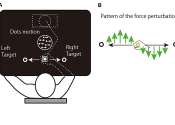A hand (med./lat.: manus, pl. manūs) is a prehensile, multi-fingered extremity located at the end of an arm or forelimb of primates such as humans, chimpanzees, monkeys, and lemurs. A few other vertebrates such as the koala (which has two opposable thumbs on each "hand" and fingerprints remarkably similar to human fingerprints) are often described as having either "hands" or "paws" on their front limbs.
Hands are the chief organs for physically manipulating the environment, used for both gross motor skills (such as grasping a large object) and fine motor skills (such as picking up a small pebble). The fingertips contain some of the densest areas of nerve endings on the body, are the richest source of tactile feedback, and have the greatest positioning capability of the body; thus the sense of touch is intimately associated with hands. Like other paired organs (eyes, feet, legs), each hand is dominantly controlled by the opposing brain hemisphere, so that handedness, or the preferred hand choice for single-handed activities such as writing with a pen, reflects individual brain functioning.
Some evolutionary anatomists use the term hand to refer to the appendage of digits on the forelimb more generally — for example, in the context of whether the three digits of the bird hand involved the same homologous loss of two digits as in the dinosaur hand.
The hand has 27 bones, 14 of which are the phalanges (proximal, medial, and distal) of the fingers. The metacarpal is the bone that connects the fingers and the wrist. Each human hand has 5 metacarpals.









